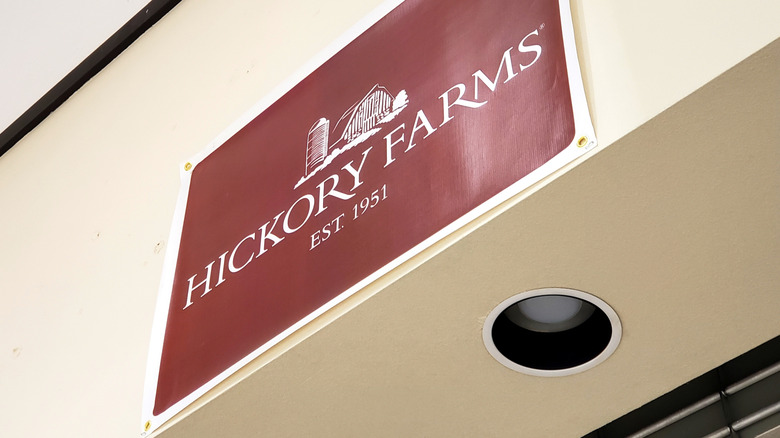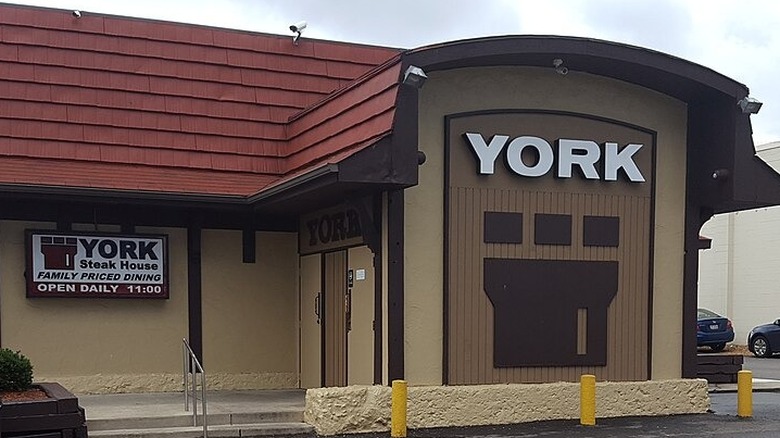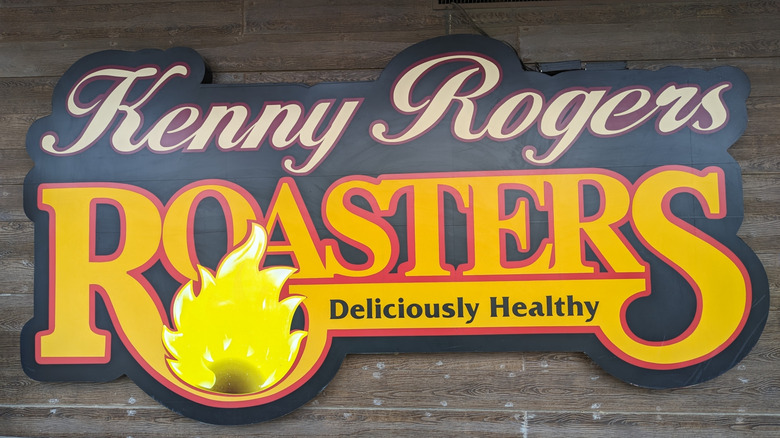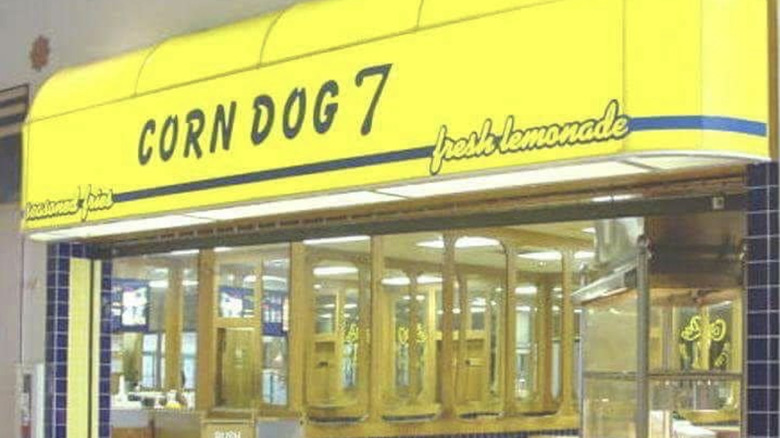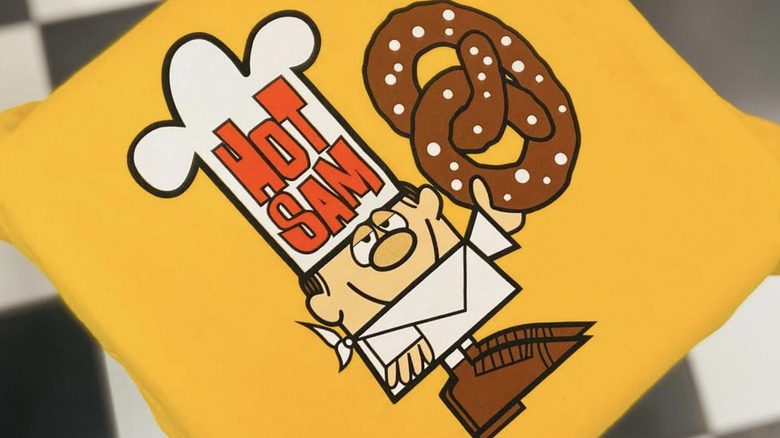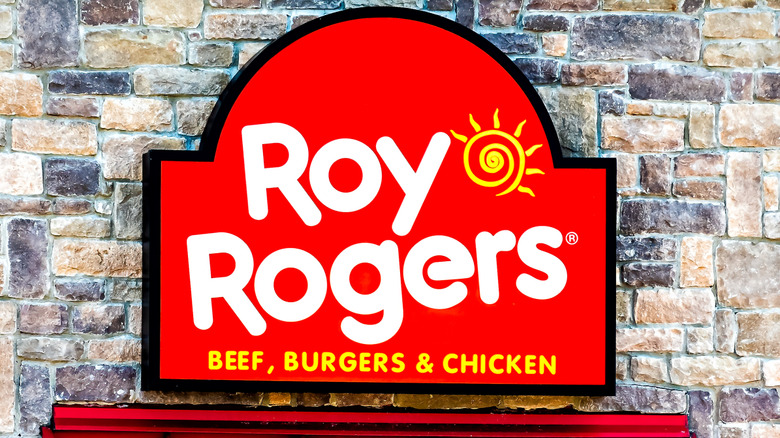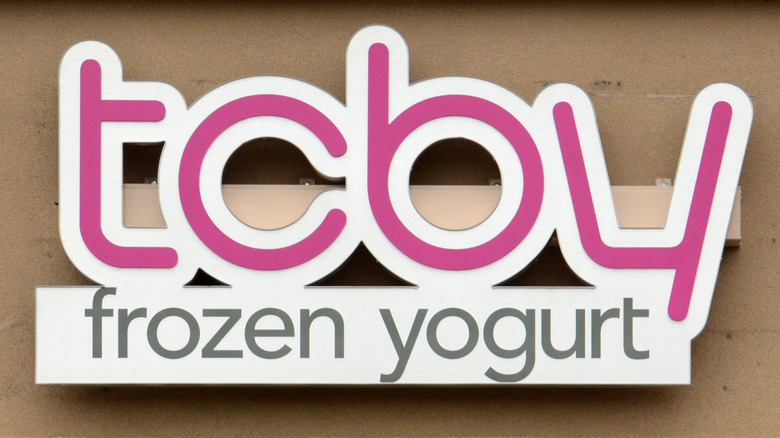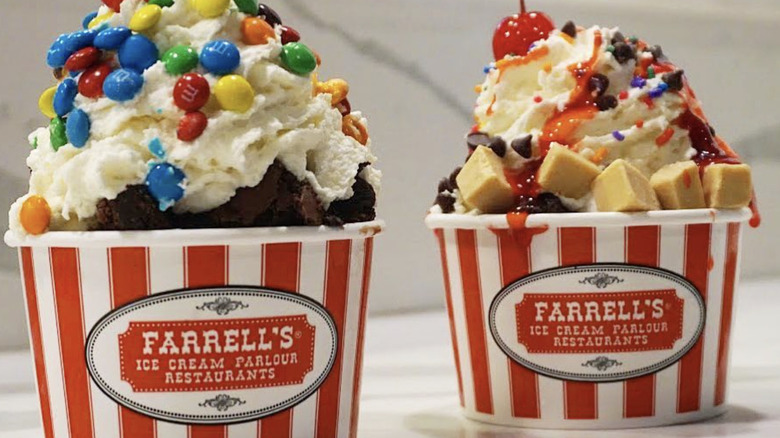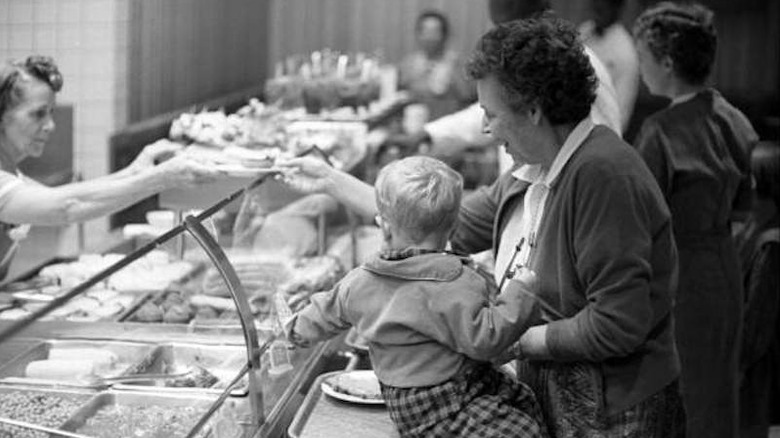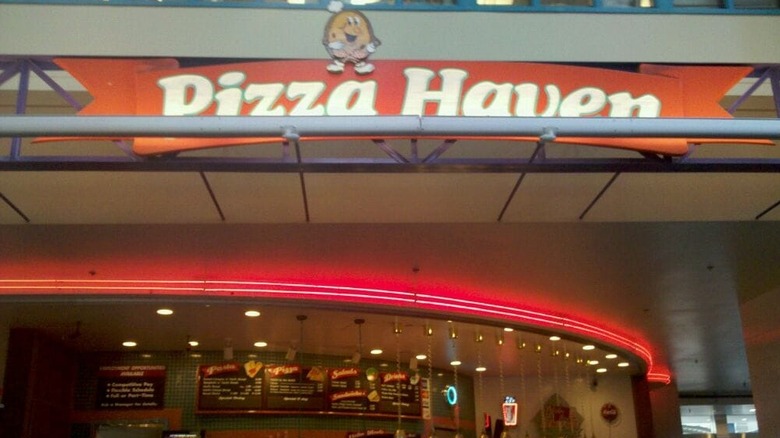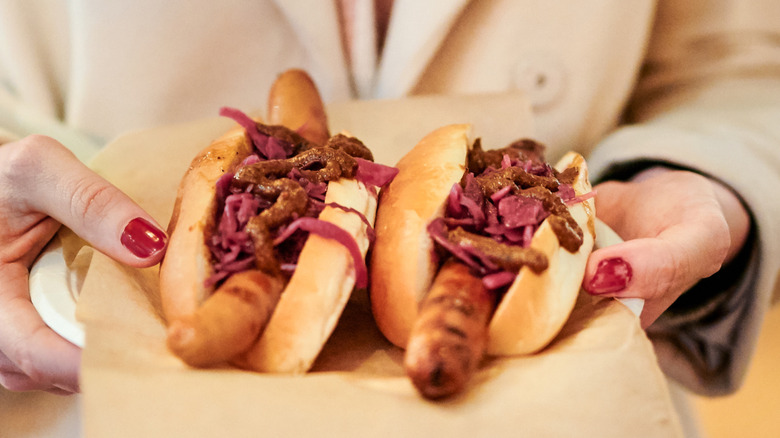Old School Mall Food Court Restaurants That Disappeared
For better or for worse, a trip to the mall is all about entertainment and consumption. How good it feels to stroll around and buy stuff, whether you need it or not, and to keep the party going, or to obtain necessary refreshments with a trip to the mall's food court or other food options right there on the premises. For many, a day at the mall isn't really complete without the ritualistic eating or drinking of a pretzel, hot dog, Orange Julius, or a slice of the one pizza at Sbarro worth ordering.
Food courts are a savior of America's dying malls, and its nearly standardized food options are integral to the history of the shopping center, shortly after those complexes started rapidly popping up in the 1950s and 1960s. Over the years, certain eateries became synonymous with malls, whether that was the only place those restaurant companies did business or not. And then, like so many of the malls that once housed them, those establishments have disappeared as a result of a changing retail landscape.
So many once prominent chain restaurants that could be found at hundreds or even thousands of malls simply don't exist anymore, or they've been bought out by other restaurants, or they're a shadow of their former selves. Here are some of the most formerly popular mall food court staples that virtually vanished.
Hickory Farms
Probably the most quintessential mall food spot, or at the least one inextricably linked to shopping centers in the collective consciousness: Hickory Farms. Primarily a store that sold shelf-stable beef logs, summer sausage, processed cheeses, and specialty mustard, both on their own and in various sized gift boxes, most Hickory Farms mall outlets would operate a small food stand. On the bill of fare: processed meats similar to the ones sold in boxes and baskets, but served up hot and on a stick. A Hickory Farms cheddar brat, very hot, a little spicy, and oozing the smallest amount of cheese product, paired well with shopping in the 1970s and 1980s. At its commercial peak, there were 550 Hickory Farms stores, predominantly located in malls in the United States and Canada.
But over most of the 1980s and into the 1990s, sales fell precipitously at Hickory Farms. By the holiday rush of late 1999, only 18 mall stores remained open. In early 2000, the company announced its plans to close what shops remained, permanently turning off the cheddar brat rotating machine in order to focus on selling packaged meats and cheeses through its catalog and website and in limited-time pop-up stores around the winter holidays.
York Steak House
A bridge from the sit-down dining to fast food, a midway point between the regular restaurant and the facade-style eateries most commonly found mall options, York Steak House was a full service establishment that served high quality, elaborate meals. It found its niche in the emerging mall culture of the mid-20th century. Eddie Grayson and Berndt Gros opened their first York Steak House in 1966 in a Columbus, Ohio, restaurant pod — a free-standing food court — and then focused almost entirely on malls. It's a strategy picked up by General Mills Restaurant Group, which purchased outright the burgeoning York Steak House Chain in 1977 and took it national.
At its peak, there were nearly 200 York Steak Houses, and almost all of them were tacked on to the side of malls. Customers dined off of a traditional steakhouse menu, choosing between several different beef cuts, chicken options, and fish selections. Dishes came with a potato side, bread, and a single trip to the then-novel salad bar — a chain restaurant feature that's now almost gone for good.
But as malls evolved, so too did the food options. As food courts with numerous, inexpensive fast food options came around, York couldn't compete. The very last York Steak House, in the chain's origin point of Columbus, Ohio (which fed hungry shoppers in the old Westland Mall across the street) remains open as of 2025.
Kenny Rogers Roasters
Though his name and face emblazoned most everything associated with the restaurants chain, including its television commercials, country-pop superstar Kenny Rogers didn't have a whole lot to do with Kenny Rogers Roasters beyond financial participation and pulling a profit. John Y. Brown, the entrepreneur who transformed the now-struggling Kentucky Fried Chicken into a global brand, delved back into the poultry game in 1991, this time licensing Rogers' image to sell Americans on wood-roasted and barbecued chicken, served alongside homestyle sides. After a launch in Florida, there were more than 100 Kenny Rogers Roasters in the U.S., in food courts, just outside of malls, and in their own buildings.
Kenny Rogers Roasters would top out at 425 locations, but by 1998, not enough people were buying full chicken dinners at the mall for the company to survive any longer. It went bankrupt, and almost all of its North American locations, both the ones inside of shopping malls and operating elsewhere, closed down. The final American Kenny Rogers Roasters lasted in the Ontario Mills Mall in Ontario, California, until 2011 — but it's still a competitive fast food brand in Asia, where a franchiser opened up shop in 2008.
Corn Dog 7
The best mall foods are ones that are portable, and not messy, and which can be consumed with one hand. That would explain why the corn dog is a mainstay of the mall food court, particularly when served by restaurants that devoted their existence to perfecting the simple dish of a wiener dredged in thick, cornmeal-based batter and then deep-fried in hot oil until it's golden brown.
Starting in 1978, Corn Dog 7 (named for the seven relatives that opened the business together) was the kind of place where shoppers went when they absolutely needed a corn dog. Of course, with those fryers always bubbling and waiting, Corn Dog 7 could make and sell other oil-dunked mall snacks, too, particularly funnel cakes and cheese-on-a-stick.
By 1991, nearly 100 malls hosted a Corn Dog 8 miniature restaurant in its food courts, with about half company-owned and half franchised out. Soon after, the decline began. While a new location opened in July 2025 in Mississippi in a non-mall situation, Corn Dog 7 is now a chain of just two restaurants.
Hot Sam
Contemporary shopping malls are an evolution of shopping promenades with a little bit of a traveling carnival vibe thrown in, which explains why the food court often includes establishments where consumers can grab the kind of refreshments served at those places of yore, salty and sweet treats like pretzels. While Auntie Anne's, Wetzel's Pretzels, and Pretzelmaker continue to keep a presence in what malls are still standing, the first name in mall pretzels is long gone.
Hot Sam Pretzels opened its first location in suburban Detroit in the mid-1960s, serving big, soft, Bavarian-style pretzels prepared in rotating ovens. The hard-to-pass-up aroma of baking pretzels lured customers to the stand, and over the next two decades, as malls proliferated across the United States, so did Hot Sam, which operated 175 domestic locations by 1985. It was such a cash cow, raking in as much as $50 million a year, that diversifying mall cookie chain Mrs. Fields bought Hot Sam in 1995. A year later, it also purchased Hot Sam's upstart competitor and systematically began merging the two pretzel companies. By 2005, every extant Hot Sam had been converted into a Pretzel Time, which now goes by the name Pretzelmaker.
Roy Rogers
Western movie star and balladeer Roy Rogers was once so famous that his name could and was used to sell fast food. In 1968, the Marriott Corporation opened its first Roy Rogers restaurant in Virginia, seeking to compete with three of the biggest fast food brands of the day: McDonald's, Kentucky Fried Chicken, and Arby's. The real Roy Rogers was paid a licensing fee for his name and image and he promoted the chain, which boasted a sprawling menu offering something for everyone including hamburgers, fried chicken, and roast beef sandwiches.
Within just two decades, Roy Rogers was an institution in the northeastern United States, with most of its almost 650 outlets doing business in that region. Lots of those spots were in malls, which opened in droves in the 1960s, 1970s, and 1980s, and Roy Rogers could slide right into their food courts with its cheap and varied menu of familiar food served fast.
In 1990, Hardee's bought out the Roy Rogers brand, and worked quickly to convert the vast number of locations of its vanquished competitor into those bearing its own signage and menu. By the early 2000s, only about 60 Roy Rogers were left intact, and that number plummeted to just 40 as of 2025. Most are freestanding, a few exist in truck stops, and even less occupy spots in mall food courts.
TCBY frozen yogurt
The frozen yogurt landscape of the 2020s comprises two standards: the high-end, purportedly healthy fare sold by the likes of Pinkberry, and the topping-abundant, self-serve, build-your-own fro-yo sundae bars that popped up in thousands of strip malls around the country. It's a much different world than when frozen yogurt, a lower-fat, lower-sugar alternative to ice cream comparable to soft serve, enjoyed its initial burst of popularity in the 1980s.
TCBY, originally called The Country's Best Yogurt in full, grew explosively in the dieting-oriented 1980s, going from one store in 1981 to more than 100 in just three years. By the early 2000s, there were around 3,000 TCBYs in business, many of them in malls, where they operated like traditional ice cream stores: An employee dispensed one or more frozen yogurt flavors into a cone or cup and loaded it up with the toppings of the customer's choice.
Malls were such a core part of TCBY's business that when the shopping center economy began to decline in the 2010s and beyond, the yogurt chain had to close down stores to make ends meet. People not going to malls as much anymore, coupled with the rise of chains like Pinkberry, which operate in more trafficked areas, spelled the slow disappearance of TCBY. There are still around 125 outlets in the U.S. as of 2025, both in and out of malls, but that's a tremendous drop from when TCBY dominated the frozen dessert sphere.
Farrell's Ice Cream Parlour
In what's probably a case of "you had to be there," one of the most popular and prized birthday party destinations or site of special outings for kids and families was an ice cream parlor that transported patrons back in time to the 1890s. Evoking some of the oldest ice cream shops in the U.S., Farrell's Ice Cream Parlour sold eye-popping and mountainous ice cream sundaes and banana splits, served up by staff in old-timey striped outfits and boater hats while ragtime standards blared out from super-loud player pianos.
After opening in Portland, Oregon, in 1963, the chain had grown to 130 locations just over a decade later, thanks to a cash infusion from a purchase by the Marriott Corporation. Farrell's proved particularly popular at well-traveled areas where people congregated, such as shopping malls, its impossibly large ice cream sundaes and party rooms available in a dedicated space near the food court or the anchor stores.
One generation's treasure is the next's inexplicable weirdness, and by the mid-1980s the fun and novelty of the ice cream parlor wasn't what it once was, and Marriott sold off the chain to an investor group. A few stayed open here and there, with the last Farrell's shutting down in Brea, California, in 2019.
Morrison's
Malls could offer ample retail space to the businesses that required it, and so cafeterias, which operate with large kitchens and even larger seating areas, filled a lot of area at mid-century shopping malls. Serving up a variety of meal options, mall cafeterias represented a stopover between the cafés run by anchor department stores and fully independent restaurants and stands in the food courts that would come later. Customer-facing cafeterias offer far more than beloved high school cafeterias, and one that jumped on the mall trend was Morrison's. It offered customizable, Southern-style meals — customers would pick a meat, sides, and a bread — in Mobile, Alabama, at a steep discount from regular restaurants, in 1920.
A cheap place to eat, Morrison's survived and thrived in the Great Depression, and became a chain of 17 restaurants by the 1950s. Over the next decades, it merged with Ruby Tuesday and expanded even more, eventually comprising 142 cafeterias. In 1998, rival Piccadilly Cafeterias purchased what had been renamed Morrison Restaurants, and then went bankrupt in 2012. Mall food courts had long since supplanted cafeterias in most areas, and by 2018, only one freestanding Morrison's was left, back home in Mobile, Alabama.
Pizza Haven
So many American soldiers were stationed in Italy in World War II that they came back with a widespread hankering for pizza. Restaurants specializing in the now ubiquitous dish flourished in the 1940s and 1950s, and in Seattle, one of the regional favorites was Pizza Haven, established in 1958. The popularity of pizza gave way to the rise of the shopping mall, which created the perfect environment for Pizza Haven to grow in the subsequent decades. It would eventually encompass 42 stores altogether, all of them in Washington state, Oregon, and California.
One of the two founders left the company in the 1980s, and much of the chain was sold to another Pacific Northwest pizza chain, Pietro's Pizza. That restaurant group since dwindled down to two locations, while what remained of Pizza Haven filed for bankruptcy in 1998, leading to the closure of all but one shop. That final Pizza Haven, situated in the massive Seattle Center shopping and entertainment complex, served up its last slice in 2012.
The Great Hot Dog Experience
At one point in the latter decades of the 20th century, it must have seemed like every mall provided multiple options to grab a hot dog or frankfurter. While plenty of food court chains included the very fast and easy meal choice on their menus, some companies devoted their entire business to the hot dog in a roll. By 1980, one of the leaders in mall hot dogs was a Minnesota-based umbrella corporation called Carousel Snack Bars.
In addition to easy-to-make, standard snack bar stuff like pizza, nachos, french fries, and burgers, the collection of different food court restaurants all owned and operated by Carousel was headlined by three hot dog joints: The Great Hot Dog Experience, Hot Dogs and More, and International Sausages. The mall economy served Carousel well in the 1980s, as it jumped from running 240 stores in 1980 to 325 just seven years later.
One of the more visible and less generic names in fast food and food courts, A&W, also sold hot dogs. In 1997, A&W bought Carousel Snack Bars. None of its '80s-era hot dog chains are still around.
Karamelkorn
While best remembered as a mall institution, along with myriad other storefront popcorn vendors, Karamelkorn got started as a downtown shop in Casper, Wyoming, in 1929. Other locations in other cities followed until it embraced the emergence of malls in the 1960s and grew along with that new, novel retail premise.
By the time the 1980s rolled around, there were 270 narrow Karamelkorn stores in malls, both in food courts and nestled among the general retail areas, in 43 states. Popcorn is a great snack, and an ideal food for walking around with, making it an ideal fit for malls. Karamelcorn made the otherwise inexpensive and mundane popcorn special and enticing by offering it in a number of varieties to mall denizens, most notably a caramel corn.
After Karamelkorn came under the same corporate ownership as Dairy Queen and Orange Julius, its products were sold at multi-brand mall food court shops in the "Triple Treat" format. A few holdouts still operated under the Karamelkorn name, offering caramel, cheese, and cinnamon flavored popcorns, until Dairy Queen shut down the final six in 2019. Today, Karamelkorn is known as Karamelcorn, and it's a mail-order popcorn business operating out of Nebraska.

